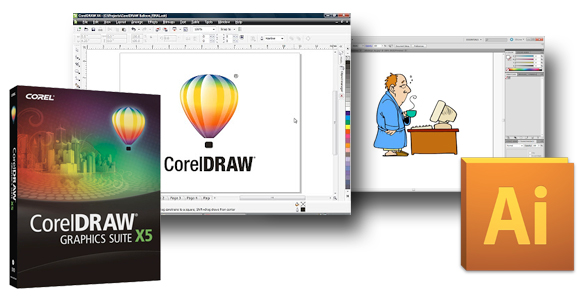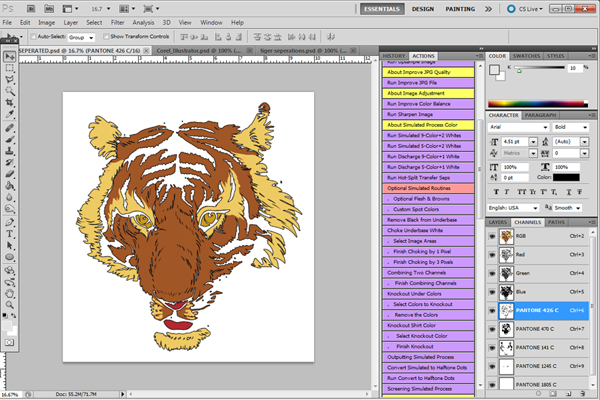To start any job, we need artwork. We have a few options. Depending
on the target market, we’ll either create our own artwork, receive
artwork from the customer, or more likely, some combination of the two.
This is usually an area of difficulty for new screen printers, unless
you happen to be starting your business as a graphic designer as well.
Most of the customers who come to you will have little understanding of
what kind of artwork we as printers need, or what we are capable of
reproducing on shirts with screens.

Art Programs
First are the art programs. If you plan to use a PC for
artwork, chances are you will use Corel Draw for your graphics. Just as
likely you will use Adobe Illustrator if you are a Mac user.
Both these programs are vector based. With a vector program, you will do
all spot color work (blocks of color and line art) and special
lettering effects. In vector programs, you can change the size of the
image with no effect on the quality of the image.
The majority of
custom screen printers, businesses who print for any customer in need of
custom printing, do nothing beyond spot color and lettering effects for
their customers. Most custom printed T-shirts you see today are
produced with these spot color images.
If you choose to do any photographic images on shirts, you’ll need to use Adobe Photoshop as well.
Photoshop, in both the PC and Mac version, is a raster (or pixel) based
program. For photographic reproduction on a garment, you will likely
purchase one of the automatic separation programs as well. Separation software
will “look” at your full color image in Photoshop and automatically
create the separations needed to reproduce the image on a shirt.

There are training courses via DVD,
webinars and trade show seminars that will address each of these
programs specific to screen printing. Generic training, say at your
local community college, will spend much time discussing web design,
etc., so training specific to the garment printing industry will be a
real plus.
Film Positives
Once you have a finished piece of artwork that both you and your customer have agreed upon, we’ll need to create a film positive.
This film positive will generally be a black image printed on clear
acetate film. A three color design, red, yellow and black, will be
output onto three separate films, all with the images in black. There
are a variety of ways to create a film, but most operators today, both
large and small, will use an inkjet printer for output.
Output Device for Your Film
If you plan to print any halftone dots (shades of color) you will need RIP software.
By halftones, we’re talking about printing, for example, a solid green
image, and also green in halftone dots to create a lighter shade of
green, all from a single screen. You will also use halftone dots to give
the illusion of depth in an image and to blend together two or more
colors for a more colorful design with the fewest number of screens.
RIP is an abbreviation for Raster Image Processor.
Inkjet printers, while giving you an excellent film positive to work
with, are in fact full color printers. These printers always “think”
they are printing in color. Halftone dots give the illusion of a shade of color. The inkjet printer will try to help you out when it sees halftones, and will print these dots in grey rather than black. Grey dots will not expose on your screen.
On
the other hand, RIP software revolutionized the industry by “telling”
your inkjet printer, “When you see halftone dots, print solid black
dots.” And that is why, sooner or later, you will absolutely need RIP software to output film positives on an inkjet printer.
Be cautious here. You need RIP software that is specific to screen printing and film positive output.
A RIP from an inkjet machine manufacturer will be a color management
product and not for the purpose of outputting solid black dots. So when
the salesman at the office supply store says he has RIP software, he’s
referring to color management software, and will not likely even
understand what you are trying to achieve by printing solid black dots.
Color management software will not recognize your halftones. Your RIP software must be specific to film output.
You
may already be using a laser printer for your film output, or such a
device has been recommended to you. Will a laser printer work? Yes. Is it the best device? No. Output
from a laser printer tends to not be opaque enough to easily expose a
screen, so you will find yourself underexposing your screens to get the
image to wash out.
Laser printers use heat during processing, so film positives from this device tend to shrink.
This shrinkage will be of little consequence on one-color jobs, but
registration of multiple colors can be very difficult using laser
output. If you are already using laser, keep going as you are until
you’re ready to upgrade. If you have yet to buy an output device, inkjet with RIP software is the product of choice today.
Remember, it is not necessary to overbuy inkjet printers. Most screen printers will never make films larger than 13x18, so an inexpensive Epson printer will do an excellent job. If you will be doing regular output more in the 17x22 range, a larger format (and more expensive) printer will be required.